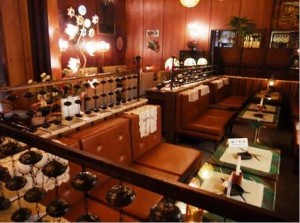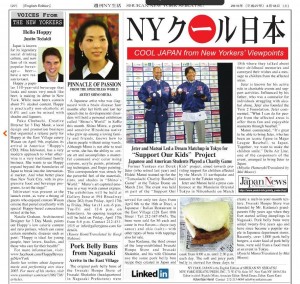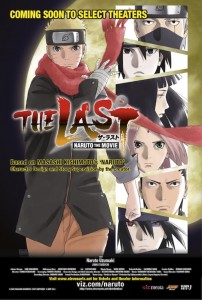WIT Life #290: Round Trip Heart/Our Little Sister
WIT Life is a periodic series written by professional Writer/Interpreter/Translator Stacy Smith (Kumamoto-ken CIR, 2000-03). She starts her day by watching Fujisankei’s newscast in Japanese, and here she shares some of the interesting tidbits and trends along with her own observations.
A business trip to Japan prevented me from viewing the majority of the films at this year’s Japan Cut s at Japan Society, but I was able to catch Round Trip Heart (ロマンス) during the festival’s opening week. Starring Yuko Oshima best known as a singer from the idol group AKB48, this film tells the story of an emotionally lost young woman whose job is to serve refreshments on board the train servicing the hot springs area of Hakone just outside Tokyo. It is through a chance encounter with a seemingly sleazy customer that enables her to examine her past and be able to look toward the future. This seemingly simple but touching movie made its North American premiere at Japan Cuts and was released in Japan the next week, so it was cool to be able to get a sneak peak ahead of the domestic market.
s at Japan Society, but I was able to catch Round Trip Heart (ロマンス) during the festival’s opening week. Starring Yuko Oshima best known as a singer from the idol group AKB48, this film tells the story of an emotionally lost young woman whose job is to serve refreshments on board the train servicing the hot springs area of Hakone just outside Tokyo. It is through a chance encounter with a seemingly sleazy customer that enables her to examine her past and be able to look toward the future. This seemingly simple but touching movie made its North American premiere at Japan Cuts and was released in Japan the next week, so it was cool to be able to get a sneak peak ahead of the domestic market.
Although I was sad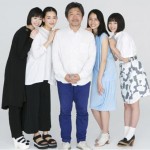 to miss most of Japan Cuts, being in Tokyo allowed me to check out the newest work from my favorite Japanese director, Hirokazu Kore-eda, who I have written about numerous times here. It is called Our Little Sister (海街diary, literally Seaside Town Diary) and is based on the eponymous manga by Akimi Yoshida. It tells the story of Read More
to miss most of Japan Cuts, being in Tokyo allowed me to check out the newest work from my favorite Japanese director, Hirokazu Kore-eda, who I have written about numerous times here. It is called Our Little Sister (海街diary, literally Seaside Town Diary) and is based on the eponymous manga by Akimi Yoshida. It tells the story of Read More
The Global Shine Initiative – Intriguing Opportunity for Female JET Alumni
Posted by Sebastian Shimomichi, a Data Analyst for marketing at an IT firm & upcoming software developer. Click here to join the JETwit Jobs Google Group and receive job listings even sooner by email.
The “Global Shine Initiative” has announced the launch of a global roll out of female empowerment programmes focused on ‘Finding Balance’ to facilitate a ‘top-down’ approach to increasing the number of female leaders.
- Finding Balance Europe (London)
- Shine Open Programme, August 19th – 21st
- Finding Balance Asia (Tokyo)
- Shine Open Programme, September 2nd – 4th
- Finding Balance UAE (Dubai)
- Shine Open Programme, September 11th – 13th
WIT Life #289: NY Asian Film Festival
WIT Life is a periodic series written by professional Writer/Interpreter/Translator Stacy Smith (Kumamoto-ken CIR, 2000-03). She starts her day by watching Fujisankei’s newscast in Japanese, and here she shares some of the interesting tidbits and trends along with her own observations.
This year’s NY Asian Film Festival is showcasing 11 films as part of its focus on new cinema from Japan. I had the chance to catch two of them, Permanent Nobara (パーマネント野ばら) and Chasuke’s Journey (天の 茶助).
茶助).
The former flick stars the drama and film fixture Miho Kanno and the seemingly non-aging Yosuki Eguchi in a story set in a small fishing village in Shikoku (with dialogue in the regional dialect). Kanno’s character Naoko has returned to her hometown with her daughter, after divorcing her husband and leaving her life in Tokyo. Her mom runs the only town’s beauty salon, whose signature service is perms. The regulars gather there to snack and gab while getting their hair done, and this convivial and often raunchy atmosphere reminded me of the relationships between the women in Steel Magnolias.
Various aspects of Naoko’s life growing up in the village are revealed via flashback, including Read More
Justin’s Japan: Nippon in New York—JAPAN CUTS, Kishi Bashi, ‘Kafka on the Shore,’ Keiko Matsui
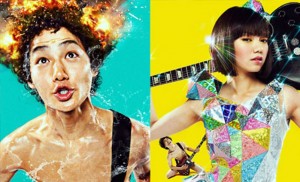
HIBI ROCK: Puke Afro and the Pop Star kicks off this year’s JAPAN CUTS film festival at Japan Society July 9. (© 2014 HIBI ROCK Film Partners)
By JQ magazine editor Justin Tedaldi (CIR Kobe-shi, 2001-02) for Examiner.com. Visit his Japanese culture page here for related stories.
After you’ve seen the outdoor fireworks, enjoy some summer events in the cool indoors, whether it’s catching one of 28 films premiering at Japan Society’s annual festival, enjoying the new sounds of electronic and jazz veterans, or witnessing an all-new retelling of the work of contemporary Japan’s most influential novelist.
This month’s highlights include:
July 9-19
Japan Society, 333 East 47th Street
$13, $10 Japan Society members, seniors and students (most screenings)
North America’s largest festival of new Japanese film, the ninth annual edition of JAPAN CUTS is proud to present actress Sakura Ando with the CUT ABOVE Award for Outstanding Performance in Film, presenting her latest great performances in two new films for the festival’s Centerpiece Presentation. Shingo Wakagi’s elegant Banana Yoshimoto adaptation Asleep makes its North American premiere, and Masaharu Take’s fantastic slacker-to-boxer pathos-drenched comedy 100 Yen Love is presented in its North American premiere, followed by the PUNCH LOVE Party. The festival’s Closing Film is perhaps one of the most memorable Japanese titles of the decade: Juichiro Yamasaki’s Sanchu Uprising: Voices at Dawn, being shown for the first time outside of Japan. Director Yamasaki appears at the festival to present this remarkable independent period film, which offers a valuable fable for the political consciousness of the contemporary moment.
Monday, July 20, 7:00 p.m.
$40
Having collaborated and toured with of Montreal, Regina Spektor, and now Guster, singer, violinist, and composer K Ishibashi (aka Kishi Bashi) embarks on an epic orchestral solo project. His solo live show is a dazzling array of looping and vocal/violin gymnastics. Bright and soaring avant-pop songs are prevalent, as are Eastern-tinged arrangements, gentle ballads, Philip Glass-inspired improvisations, and more than a few moments that flirt with ‘70s prog (in the tradition of ELO or Yes). Jarringly kaleidoscopic, but it works.
July 21-23
High Line at the Rail Yards, West 30th Street and Eleventh Avenue
Free
Aki Sasamoto presents Food Rental, a new performance for which she will bring a custom-built food cart to the High Line’s newest section. From her perch inside the cart, the artist will offer visitors an à la carte selection of micro performances and playful narrative demonstrations. Like an off-kilter life hacking workshop, Food Rental will continue Sasamoto’s history of performances that engage visitors with sneakily shifting stage sets and unruly props.
For the complete story, click here.
Justin’s Japan: Wismettac Wows at Japanese Food Fest
By JQ magazine editor Justin Tedaldi (CIR Kobe-shi, 2001-02) for Shukan NY Seikatsu. Visit his Examiner.com Japanese culture page here for related stories.
Lovers of Japanese food and drink gathered at 230 Fifth in Midtown Manhattan on June 20 for the Wismettac Asian Foods 2015 NY Premium Sake and Shochu Tasting Event, an annual business-to-business gathering that served up a foodie’s paradise.
Formerly known as Nishimoto Trading Co., Ltd. USA, Wismettac Asian Foods, Inc. was established in Kobe in 1912, and is one of the oldest importers, wholesalers and distributors of Asian food products in North America. It is well known in the U.S. for its Shirakiku brand food products, which include rice, noodles, and seafood.
Now in its eighth year, the event featured around 25 different Japanese sake and shochu companies and 15 different food manufacturers. It’s a place where one can enjoy piping hot savory katsudon curry rice followed by chocolate mochi ice cream with freshly sliced strawberries, finishing with a crisp, refreshing selection of daiginjo sake.
“Participating in this event is a great opportunity, because I can introduce Japanese culture and it’s a great way to introduce how to use Japanese ingredients properly to make a delicious dish,” said Hideko Lilley, a sales associate for Wismettac attending the New York event for her third year.
For more on Wismettac, visit www.ntcltdusa.com.
Invest in Japan: Mie Business Seminar and Exchange Meetings (London)
Posted by Sydney Sparrow, curriculum and content developer for a real estate schools based in Virginia. Click here to join the JETwit Jobs Google Group and receive job listings even sooner by email.
Located in the middle of Japan, Mie prefecture is an area of technology and manufacturing that lies along the main highway connecting east and west Japan. Mie prefecture is an industry and innovation hub where there is great potential for foreign companies. In this seminar, we will not only explain Mie’s excellent location, appealing industries and variety of industrial clusters, but also introduce the nature, culture and charms of life in this region.
Dates: Monday, July 6, 2015
Venue: Embassy of Japan 101-104 Piccadilly, London W1J 7JT
Program:
14:30 – 15:00 Registration
Opening Remarks and Presentations
15:00 – 15:10 Opening Remarks: Embassy of Japan
15:10 – 15.30 Presentation: Mr Eikei Suzuki, Governor of Mie Prefecture ― “Why Mie”
15:30 – 15:45 Presentation: Mr Jun Arima, Director-General, JETRO London ― “JETRO’s Support”
15:45 – 16:00 Presentation by Sir David Warren, Chairman of the Japan Society (former British Ambassador to Japan)
16:00 – 16:15 Presentation by Mr Norio Nagai, President, NABELL CORPORATION
16:15 – 16:40 Presentation by Mr Yoshihisa Kumagai, President, Mitsubishi Aircraft Corporation Europe B.V.
16:40 – 16:55 Presentation by Ms Anna Dingley, Japan and Korea Market Specialist of UK Trade and Investment ― “How UKTI can help”
16:55 – 17:10 Q&A
17:15 – 19:15 Networking Reception
Registration: This event is free of charge. To register please click here. The deadline to register is July 2, 2015 (Thursday). Please note that there is a limited number of seats available. For further information, please contact the Investment Team, JETRO London by email (Ldn_invest@jetro.go.jp) or phone (020 7421 8315).
Justin’s Japan: Nippon in New York — Pokémon Symphony, Hiromi, Kamijo, ‘ROBOT,’ AnimeNEXT
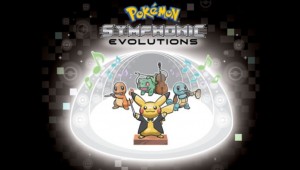
“Pokémon: Symphonic Evolutions” debuts at the Theater of Madison Square Garden June 6. (Princeton Entertainment)
By JQ magazine editor Justin Tedaldi (CIR Kobe-shi, 2001-02) for Examiner.com. Visit his Japanese culture page here for related stories.
After an unusually chilly spring, it’s finally starting to feel like summer. Enjoy some seasonal events this month that celebrate the best of both fine art and pop art.
This month’s highlights include:
June 4-5, 6:30 p.m.
New York Japan CineFest 2015: Program 1 & Program 2
Asia Society, 725 Park Avenue
$12, $10 students/seniors, $8 members
Co presented by Asia Society and Mar Creation, Inc., New York Japan CineFest highlights some of the most exciting new voices in cinema, presenting two nights of short films by emerging Japanese and Japanese American filmmakers. The first night features all-new works made within the last year, while the second night’s program spotlights female directors and is followed by a Q&A with Ema Ryan Yamazaki (Monk by Blood) and Hazuki Aikawa (Reflection). The first night’s program is followed by a reception.
June 4-7, 8:00 p.m. and 10:30 p.m.
Hiromi Trio Project featuring Anthony Jackson and Simon Phillips
Blue Note Jazz Club, 131 West Third Street
$40, $55
Part of the Blue Note Jazz Festival! A native of Hamamatsu, Japan, Grammy-winning pianist and composer Hiromi Uehara is one of the world’s top young international performers in jazz. As part of the Trio Project with bassist Anthony Jackson (Paul Simon, the O’Jays, Steely Dan, Chick Corea) and drummer Simon Phillips (the Who, Judas Priest, David Gilmour, Jack Bruce), her passionate and incendiary keyboard work has been a shining light on the jazz landscape since her 2003 debut. She takes up a four-night residency at the Blue Note in support of her latest album with the Trio Project, Alive, which was released in 2014.
June 5-6. 7:30 p.m.
Kota Yamazaki/Fluid hug-hug OQ
Japan Society, 333 East 47th Street
$25, $20 Japan Society members
Global traditions flow together in this latest work by Bessie Award-winning choreographer Kota Yamazaki. Inspired by Japanese ritual poetry readings held at the Imperial Palace, Yamazaki’s OQ (ōkyu is the phonetic reading of the Japanese word for “palace”) features dancers from diverse cultural and dance backgrounds including Western contemporary, butoh and hip-hop. Within a space designed by award-winning New York architect collective SO-IL that complements the dancers’ fluid motions, Yamazaki’s palace, with its own rituals and customs, comes to life before your eyes. The Friday, June 5 performance is followed by a MetLife Meet-the-Artists Reception.
For the complete story, click here.
JQ Magazine: JQ&A with Merry White on ‘Kissaten: Japanese Cafes Past and Present’
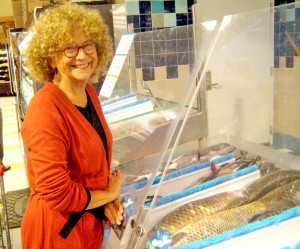
“Japanese coffee standards are the highest—when there is a new varietal on the market, it is often sent to Japan for testing. If a bean can make it in Japan, it can make it anywhere. The quality tasters are very keen, and there are fewer defective beans permitted than anywhere in the world.” (Courtesy of Merry White)
Brewing Up Something at Japan Society
By Alexis Agliano Sanborn (Shimane-ken, 2009-11) for JQ magazine. Alexis is a graduate of Harvard University’s Regional Studies-East Asia (RSEA) program, and currently works as an executive associate at Asia Society in New York City.
When it comes to notable food and drink of Japan, for many “coffee” is not the first thing that comes to mind. Yet, on May 21, Merry (Corky) White, Professor of Anthropology at Boston University, will teach audiences at Japan Society in New York City just how robust their coffee culture is, and how exacting their measurements are. Get ready for something good at Kissaten: Japanese Cafes, Past and Present.
White’s no newbie to food and Japan—it’s been much of the foundation of her professional work. If you look her up on Amazon, you’ll see that she’s been publishing food-related books since the mid-1970s, and regularly offers contributions to publications the world over. Definitely a foodie—and someone who knows her stuff. When not researching coffee and cafes, she’s active teaching about Japanese society, women in Asia, food and culture, and the anthropology of travel and tourism. Check her out on Twitter, where she regularly posts food- and culture-related content.
To whet your appetite for this program, JQ recently caught up with White to learn more about the coffee world in Japan, and what we can expect to hear from this rich presentation.
At your lecture at Japan Society, what do you hope to teach the audience about Japanese coffee culture?
I hope to surprise at least a few people, who may not yet know that Japanese coffee is a well-rooted, well-developed cultural product with a deep history. The coffee experience is also about cafes, koohii hausu, and kissaten, places with a special meaning that have developed over time in Japan. These places have offered people various distinctive experiences, depending on the era. The first ones, in the Meiji period (1868-1912), gave people a window on Europe, decor, clothing, foods—which continued into the Taisho period (1912-1926) when the flappers and lounge lizards demonstrated a new modernity, and the urban cultures were changing to, for example, give women a place in public, too. It was fine for a young woman of good family in the daytime, anyway, to go to a cafe, though probably she might have a chaperone…
Can you describe an iconic Japanese-style kissaten?
Kissaten are now places of memory, as well as ordinary community life. Brown kissa are the “sepia-toned” places where especially middle-aged people (I would say over 60s) like to go for a nice place to sit and get good service and maybe see friends. Young people like them, too, as they often share a love of the past (one they wouldn’t have had themselves) as a retro experience. Kissaten, though, also have more contemporary styles.

“By dramatizing some of the people who were on the receiving end of that racial hatred, I think the book might give a concrete sense of what American power can do when it is unleashed against people in other parts of the world. I hope the experiences of Jiro and Mitsuko make readers think twice about that.” (Louis Templado)
By Julio Perez Jr. (Kyoto-shi, 2011-13) for JQ magazine. A bibliophile, writer, translator, and graduate from Columbia University, Julio has had experience working at Ishikawa Prefecture’s New York office while seeking opportunities with publications in New York. Follow his enthusiasm for Japan, literature, and comic books on his blog and Twitter @brittlejules.
A Professor Emeritus of Harvard University, Jay Rubin has also served as a distinguished translator of Japanese literature for more than a quarter century, most notably on the works of Haruki Murakami. June 2 marks the release of his debut novel The Sun Gods (Chin Music Press), which is set in Seattle during World War II and explores the relationships between a Seattle-based Japanese national named Mitsuko and her young adopted American toddler, Billy, who are both interned by the U.S. government at the beginning of the war. Years later, Billy begins a journey to newly reconstructed Japan to find his Japanese mother and learn the truth about their shared past.
As part of the book’s launch, Rubin will be making live appearances from coast to coast, starting with Japan Society in New York on May 7 for an event titled The Magical Art of Translation: From Haruki Murakami to Japan’s Latest Storytellers, featuring other guest authors and moderated by JET alum Roland Kelts (Osaka-shi, 1998-99).
In this exclusive interview, Rubin shares with JQ the legacy of the war on his own writing, the attention to historical detail that went into The Sun Gods (with a few liberties taken), and what makes translating Japanese such a liberating experience.
JQ magazine readers are primarily JETs, JET alumni, and others who have worked and resided in Japan or have a strong interest in the country. Could you tell us about what inspired you to study Japanese language and culture and about any time you spent living in Japan?
In my second year at the University of Chicago, I was going to take one course on something non-Western for the fun of it, and one of the courses that happened to be available was an introduction to Japanese literature (in English translation, of course). I was so fascinated by the literature and by the professor’s remarks on the original language that I immediately started studying that language. I sometimes wonder what would have happened if the course I stumbled into happened to be Chinese history. I spent four years studying the language in Chicago before going to the country itself on a Fulbright fellowship. My spoken Japanese was so bad, all I could say to the young woman bartender at the first bar I wandered into was, “Do you realize you just used the word ‘wake‘ (わけ) three times?” I studied in Tokyo for two years, often wish I had made it four. I’m still remarking on how many times people use wake in sentences. I studied mostly Meiji literature while I was in Tokyo, not Noh drama like The Sun Gods’ Bill, though Noh was a side interest, and I did a lot more work on it in later years.
To start off talking about The Sun Gods, how would you describe your new book to potential readers?
This may sound like ad copy, but I’m comfortable with the summary on the book’s front flap:
Opening in the stress-filled years before World War II, The Sun Gods brings together a white minister to a Seattle Japanese Christian church, his motherless young son, and a beautiful new arrival from Japan with a troubled past. The bombing of Pearl Harbor intrudes upon whatever happiness they might have had together, and the combination of race prejudice and war hysteria carry the action from Seattle to the Minidoka Internment Camp in Idaho. Nearly two decades later, the son is ready to graduate from college when memories of Minidoka and of his erstwhile Japanese mother begin to haunt him, and he embarks on a journey that will lead him from Seattle’s International District to war-ravaged Japan in his attempt to discover the truth about his past.
The internment of people of Japanese ancestry in America that occurred during World War II is rarely dwelled on as much as other events of the war, how would you explain the internment and the reasons it warrants further attention to someone unfamiliar with the topic? What is the most important message you hope to get across?
If there’s a “message,” it’s to convey a historical moment, central to which was the fact that our government established concentration camps within its borders in order to lock up members of a particular racial group, and that this was supported by both public opinion and the Supreme Court with no constitutional justification whatsoever. The government has since apologized openly and eloquently, thus making a repeat performance highly unlikely. Japanese-American organizations, it should be noted, were among the most outspoken against anti-Muslim racism following 9/11.
Justin’s Japan: VAMPS, ‘Monkey Business,’ AKB48 at Japan Day @ Central Park

J-pop superstars AKB48 return for their first New York performance since 2009 at Japan Day @ Central Park May 10. (@AKS)
By JQ magazine editor Justin Tedaldi (CIR Kobe-shi, 2001-02) for Examiner.com. Visit his Japanese culture page here for related stories.
As spring continues and the weather continues to warm, New Yorkers can enjoy activities all over the city both indoors and out.
This month’s highlights include:
Friday, May 1, 8:00 p.m.
Best Buy Theater, 1515 Broadway
$35
Japan’s most daring rock band, VAMPS is fronted by vocalist hyde of L’arc~en~Ciel and guitarist K.A.Z of Oblivion Dust. Now touring in support of their latest album, Bloodsuckers (available on iTunes), VAMPS returns to take another bite out of the Big Apple for their first area performance since 2013.
Monday, May 4, 6:30 p.m.
Monkey Business: Japan/America Writers’ Dialogue in Words and Pictures
Asia Society, 725 Park Avenue
$15, $10 Asia Society members, $12 students/seniors
Join this annual conversation between contemporary Japanese and American authors in which Asia Society hosts an international dialogue, curated and moderated by the co-founders and editors of the Tokyo-based literary journal Monkey Business with writers who are featured in the latest edition of Monkey Business (#5), a unique, cutting-edge annual literary journal which showcases newly-translated Japanese as well as contributions from contemporary American and British writers.
Thursday, May 7, 6:30 p.m.
The Magical Art of Translation: From Haruki Murakami to Japan’s Latest Storytellers
Japan Society, 333 East 47th Street
$12, $8 Japan Society members, students/seniors
Since 1989, Jay Rubin has translated many of Haruki Murakami’s most successful and prize-winning novels, including The Wind-Up Bird Chronicle, Norwegian Wood and 1Q84. In this program, he is joined by Ted Goossen, translator of Murakami’s most recent U.S. publications, The Strange Library and Wind/Pinball: Two Early Novels, and co-editor of Monkey Business literary magazine, which showcases the best of contemporary Japanese literature for an international audience. They will discuss the unique challenges of translating modern Japanese literary works into American English, and vice versa. Rubin will also talk about his transition from translator to novelist vis-à-vis his debut novel The Sun Gods. Joining the discussion from Tokyo will be authors Aoko Matsuda and Satoshi Kitamura, and Motoyuki Shibata, friend and translating partner of Murakami. Author Roland Kelts, co-editor of Monkey Business, moderates the discussion. Followed by a reception.
For the complete story, click here.
Justin’s Japan: Hello Hoppy
By JQ magazine editor Justin Tedaldi (CIR Kobe-shi, 2001-02) for Shukan NY Seikatsu. Visit his Examiner.com Japanese culture page here for related stories.
Japan is legendary for its social drinking culture, and now fans of its most popular beverage—beer—have a new reason to toast.
Hoppy, a popular 110-year-old beverage that looks and tastes very much like beer, is making its debut in New York. While most beers contain about 5% alcohol content, Hoppy is practically non-alcoholic at 0.8%, and can be mixed with shochu and liqueurs.
Fuko Chubachi, creative director for 3 Day Monk, a local design and promotion business that organized a release party for Hoppy at East Village eatery Wasan on April 9, explains its arrival in America: “Hoppy’s CEO, Mina Ishiwatari, has a very modern approach to what otherwise is a very traditional family business. She wants to see Hoppy expand beyond the boundaries of Japan to break into the international market. And what better place than New York City, with its progressive food and beverage programs, to set the stage!”
Ishiwatari was present at the launch event, as were a throng of guests who enjoyed some custom Wasan cuisines that paired excellently with special Hoppy-based concoctions mixed at the bar.
Natalie Graham, architectural designer for 3 Day Monk, points out Hoppy’s low calorie content and zero purines, which can cause certain metabolic diseases such as gout: “Hoppy is ideal for young people, beer lovers, foodies, and those who care for their health!”
For more information, visit www.facebook.com/HoppyBeverageNewYork
Justin’s Japan: Nippon in New York — ‘Attack on Titan,’ Isamu Noguchi, Mitsuko Uchida, Sakura Matsuri
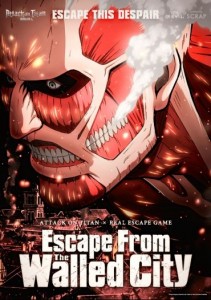
Escape from the Walled City, a live team puzzle solving challenge based on Attack on Titan, comes to Richmond County Bank Ballpark April 11. (SCRAP Entertainment Inc.)
By JQ magazine editor Justin Tedaldi (CIR Kobe-shi, 2001-02) for Examiner.com. Visit his Japanese culture page here for related stories.
Spring has sprung in the Big Apple, and that means one thing: a new season of sounds, colors, and spectacular performing arts to match the blossoming sakura trees throughout the city.
This month’s highlights include:
Now through April 26
Asia Society, 725 Park Avenue
$12/$10 seniors/$7 students; free on Fridays from 6:00 to 9:00 p.m.
Takahiro Iwasaki creates detailed miniature landscapes using towels, toothbrushes, used clothing, and other found and recycled materials. This exhibition is a part of Asia Society Museum’s ongoing In Focus series, which invites contemporary artists to create new works, often in conversation with the Asia Society Museum’s permanent collection of traditional Asian art.
April 5-May 3 11:30 a.m. and 1:30 p.m.
Blue Note Jazz Club, 131 West Third Street
$35
Blue Note Jazz Club and the Japan Foundation present the East Meets West Brunch series to introduce Japanese jazz to New York audiences. This brunch series will take place on five consecutive Sundays this spring, and features food, music and a drink. Performers include Mika Mimura Group (April 5), Hiromi Suda (April 12), Martha Kato Trio (April 19), Sumie Kaneko (April 26), and the Takeshi Ohbayashi Trio (May 3).
Saturday, April 11, 10:30 a.m., 2:30 p.m., 6:30 p.m.
Richmond County Bank Ballpark, 75 Richmond Terrace (Staten Island)
$30, $35 at the door
The titans are coming, and they’re hungry. Based on the manga megahit Attack on Titan, the newest Real Escape Game (REG) takes players to a world inhabited by giant, humanoid creatures that live for no other purpose than to make a snack of all of us. The high walls of the stadium are the only thing keeping you safe…for now. Experience the latest edition of SCRAP’s interactive storytelling and puzzle-solving games on a scale never seen before. Join thousands of other players as you decode clues inside a real stadium! Be warned, though: survival isn’t easy, and teamwork will be essential if you hope to survive. After already hosting over 40,000 players in the U.S. to date, Escape requires participants to use their best detective skills as they race against the clock.
For the complete story, click here.
Justin’s Japan: Nippon in New York — Ghibli Premiere, L’arc~en~Ciel, Steve Aoki, Rinko Kikuchi
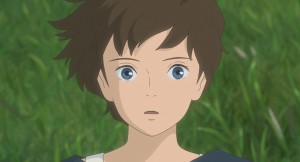
When Marnie Was There, the newest film from Studio Ghibli, premieres in North America Feb. 27 at DGA Theatre. (© 2014 GNDHDDTK)
By JQ magazine editor Justin Tedaldi (CIR Kobe-shi, 2001-02) for Examiner.com. Visit his Japanese culture page here for related stories.
Stay warm this winter with some hot local events, from an unmissable North American anime premiere, a documentary on one of Japan’s hottest acts, and concerts featuring some of the biggest names in electronic music, taiko, and indie rock.
This month’s highlights include:
Friday, Feb. 27, 8:30 p.m.
DGA Theatre, 110 West 57th Street
$16
North American premiere! The newest feature from Japan’s famed Studio Ghibli is a sweeping story of friendship, mystery, and discovery that delivers stirring emotions and breathtaking animation as only Ghibli can. When shy, artistic Anna moves to the seaside to live with her aunt and uncle, she stumbles upon an old mansion surrounded by marshes, and the mysterious young girl, Marnie, who lives there. The two girls instantly form a unique connection and friendship that blurs the lines between fantasy and reality. As the days go by, a nearly magnetic pull draws Anna back to the Marsh House again and again, and she begins to piece together the truth surrounding her strange new friend. Based on the novel by Joan G. Robinson, and directed by Hiromasa Yonebayashi (The Secret World of Arriety), When Marnie Was There has been described as “Ghibli Gothic,” with its moonlit seascapes, glowing orchestral score, and powerful dramatic portrayals that build to a stormy climax. In Japanese with English subtitles.
Sunday, March 1, 3:00 p.m.
Over the L’arc~en~Ciel: Documentary Films “World Tour 2012~”
Anthology Film Archives, 32 Second Avenue
$10
This new documentary follows a legendary rock band who never fear to take challenges on the international stage, when they have already reigned over the domestic music scene. L’Arc~en~Ciel, after celebrating their 20th anniversary, embarked on a massive world tour that no other Japanese rock band had ever done before. From March 3rd to May 31st, 2012, L’Arc~en~Ciel’s 14-city world tour hit Hong Kong, Bangkok, Shanghai, Taipei, New York, London, Paris, Singapore, Jakarta, Seoul, Yokohama, Osaka, Tokyo, and Honolulu with a total attendance of 450,000 people. The band became the first solo Japanese act ever to perform at Madison Square Garden. In Japanese with English subtitles.
Monday, March 9, 7:30 p.m. and 9:30 p.m.
Dizzy’s Club Coca-Cola, 10 Columbus Circle
$25, $15 students
Renowned Japanese pianist Chihiro Yamanaka is one of her native country’s most popular. Luckily for us, she recently moved to New York City. She’s especially well-known for leading trios, and with Jazz at Lincoln Center favorite Yasushi Nakamura on bass and rising star Kush Abadey on drums, this group stands up to those high expectations. On top of virtuosic, light-speed chops, Yamanaka has an irresistible bounce to her playing and writing.
For the complete story, click here.
Justin’s Japan: NBA D-Leaguer Yuki Togashi
By JQ magazine editor Justin Tedaldi (CIR Kobe-shi, 2001-02) for Shukan NY Seikatsu. Visit his Examiner.com Japanese culture page here for related stories.
Originally hailing from Niigata Prefecture, 21-year-old Japanese national basketball team veteran Yuki Togashi joined the Texas Legends of the NBA Development League as a point guard last November after playing in four games with the Dallas Mavericks last year during Summer League.
Togashi made his D-League debut in New York on Jan. 24, shooting a field goal in the third quarter that helped the Legends rise to a 93-92 victory over the Westchester Knicks in their inaugural season.
That same week in January, the New York Times featured a story on Yuta Watanabe, 20, a towering 6-foot-8 point guard for George Washington University. A native of Kagawa Prefecture in Shikoku, the Times dubbed him a “Basketball Ambassador” in the headline, drawing comparisons with the Asian American NBA star (and former New York Knick) Jeremy Lin.
While the 5-foot-7 Togashi could be viewed as a long shot for the NBA (where the average player is at least a foot taller), he follows in the footsteps of players like Yuta Tabuse, the “Michael Jordan of Japan” who was the first Japanese-born basketball player to play in the NBA, appearing in four games with the Phoenix Suns during the 2004-05 NBA season.
As the influence of American basketball continues to captivate Asia, Japanese youth with dreams of turning pro are working hard to take part in this exciting new era.
Justin’s Japan: Nippon in New York — Kawaii Central, Japan Week, Mr. Big, the Last ‘Naruto’
By JQ magazine editor Justin Tedaldi (CIR Kobe-shi, 2001-02) for Examiner.com. Visit his Japanese culture page here for related stories.
Stay warm this winter with some hot local events, from an exhibition for the whole family that’s perfect for introducing kids to Tokyo life, a big-screen anime farewell to a certain ninja you won’t want to miss, and an annual showcase that brings the sights (and tastes) of Japan to vivid life.
This month’s highlights include:
Now through May 17
Children’s Museum of Manhattan, 212 West 83rd Street
$11 children/adults, $7 seniors
Experience Tokyo’s vibrant culture in a new interactive exhibit! Children will have fun learning about life in present day Japan in this playful, highly immersive environment that transports families to two distinct areas of Tokyo that exist side by side: one serene and exquisite, the other, too cute for words. Kawaii Central is a streetscape inspired by Tokyo’s bustling Harajuku district, bursting with color, trendy shops and cuter than cute styles. Kids sing karaoke, smile for the photo booth camera, serve up a seasonal Japanese meal, and design adorable mascots for their families. Plus, learn more about contemporary Japan through special programs for the public, free with admission.
Jan. 29-31, 7:30 p.m.
Miwa Yanagi Zero Hour: Tokyo Rose’s Last Tape
Japan Society, 333 East 47th Street
$35, $28 Japan Society members
Stranded in Japan during World War II, a young Japanese-American woman was forced to serve as a radio broadcaster for a propaganda program controlled by the Japanese Imperial Army, and was subsequently tried for treason. Seventy years later, this historic incident is brought to life through a visually stunning whodunit, conceived, written and directed by internationally renowned visual artist Miwa Yanagi. Brimming with iconic imagery from her rich body of photographic work, Zero Hour tells the multi-layered story of a woman caught between two nations during the war. This presentation marks Yanagi’s North American debut as a theater artist. Performed in English and Japanese with English subtitles.
Feb. 7-8
Music from Japan: East Asian Vibrancy and Highlights of MFJ Commissions III
Asia Society, 725 Park Avenue
$20-$40
Over two days, Music from Japan’s 40th anniversary will be commemorated with exciting cross-cultural collaborations between musicians from Japan and its neighboring countries, China and Korea. Three internationally acclaimed traditional instrumentalists from Japan, Korea, and China will perform contemporary and classical repertoire on their respective instruments. A series of solo works will be followed by a group improvisation and the world premiere of Unkai (Sea of Clouds), written by MFJ-commissioned composer Ned Rothenberg especially for the occasion. The following afternoon, to celebrate MFJ’s long history of commissioning Japanese and American composers to create new work, two new MFJ commissions will be presented alongside a retrospective of compositions from prior years.
For the complete story, click here.


